
- •Table of Contents
- •About the Author
- •About the Technical Reviewer
- •Acknowledgments
- •Introduction
- •Installing Visual Studio
- •Visual Studio 2022 System Requirements
- •Operating Systems
- •Hardware
- •Supported Languages
- •Additional Notes
- •Visual Studio Is 64-Bit
- •Full .NET 6.0 Support
- •Using Workloads
- •The Solution Explorer
- •Toolbox
- •The Code Editor
- •New Razor Editor
- •What’s Available?
- •Hot Reload
- •Navigating Code
- •Navigate Forward and Backward Commands
- •Navigation Bar
- •Find All References
- •Find Files Faster
- •Reference Highlighting
- •Peek Definition
- •Subword Navigation
- •Features and Productivity Tips
- •Track Active Item in Solution Explorer
- •Hidden Editor Context Menu
- •Open in File Explorer
- •Finding Keyboard Shortcut Mappings
- •Clipboard History
- •Go To Window
- •Navigate to Last Edit Location
- •Multi-caret Editing
- •Sync Namespaces to Match Your Folder Structure
- •Paste JSON As Classes
- •Enable Code Cleanup on Save
- •Add Missing Using on Paste
- •Features in Visual Studio 2022
- •Visual Studio Search
- •Solution Filters
- •Visual Studio IntelliCode
- •Whole Line Completions
- •Visual Studio Live Share
- •Summary
- •Visual Studio Project Types
- •Various Project Templates
- •Console Applications
- •Windows Forms Application
- •Windows Service
- •Web Applications
- •Class Library
- •MAUI
- •Creating a MAUI Application
- •Pairing to Mac for iOS Development
- •Consuming REST Services in MAUI
- •The Complete Weather App
- •The Target Platforms
- •The Required NuGet Package
- •The Weather Models
- •The WeatherService
- •The MainViewModel
- •Registering Dependencies
- •Building the MainPage View
- •Using SQLite in a MAUI Application
- •The ToDoItem Model
- •The ToDoService
- •The MainViewModel
- •Registering Dependencies
- •Building the MainPage View
- •Managing NuGet Packages
- •Using NuGet in Visual Studio
- •Hosting Your Own NuGet Feeds
- •Managing nmp Packages
- •Creating Project Templates
- •Creating and Using Code Snippets
- •Creating Code Snippets
- •Using Bookmarks and Code Shortcuts
- •Bookmarks
- •Code Shortcuts
- •Adding Custom Tokens
- •The Server Explorer
- •Running SQL Queries
- •Visual Studio Windows
- •C# Interactive
- •Code Metrics Results
- •Maintainability Index
- •Cyclomatic Complexity
- •Class Coupling
- •Send Feedback
- •Personalizing Visual Studio
- •Adjust Line Spacing
- •Document Management Customizations
- •The Document Close Button
- •Modify the Dirty Indicator
- •Show Invisible Tabs in Italics in the Tab Drop-Down
- •Colorize Document Tabs
- •Tab Placement
- •Visual Studio Themes
- •Summary
- •Setting a Breakpoint
- •Step into Specific
- •Run to Click
- •Run to Cursor
- •Force Run to Cursor
- •Conditional Breakpoints and Actions
- •Temporary Breakpoints
- •Dependent Breakpoints
- •Dragging Breakpoints
- •Manage Breakpoints with Labels
- •Exporting Breakpoints
- •Using DataTips
- •Visualizing Complex Data Types
- •Bonus Tip
- •Using the Watch Window
- •The DebuggerDisplay Attribute
- •Evaluate Functions Without Side Effects
- •Format Specifiers
- •dynamic
- •hidden
- •results
- •Diagnostic Tools
- •CPU Usage
- •Memory Usage
- •The Events View
- •The Right Tool for the Right Project Type
- •Immediate Window
- •Attaching to a Running Process
- •Attach to a Remote Process
- •Remote Debugger Port Assignments
- •Remote Debugging
- •System Requirements
- •Download and Install Remote Tools
- •Running Remote Tools
- •Start Remote Debugging
- •Summary
- •Creating and Running Unit Tests
- •Create and Run a Test Playlist
- •Testing Timeouts
- •Using Live Unit Tests
- •Using IntelliTest to Generate Unit Tests
- •Focus IntelliTest Code Exploration
- •How to Measure Code Coverage in Visual Studio
- •Summary
- •Create a GitHub Account
- •Create and Clone a Repository
- •Create a Branch from Your Code
- •Creating and Handling Pull Requests
- •Multi-repo Support
- •Compare Branches
- •Check Out Commit
- •Line Staging
- •Summary
- •Index
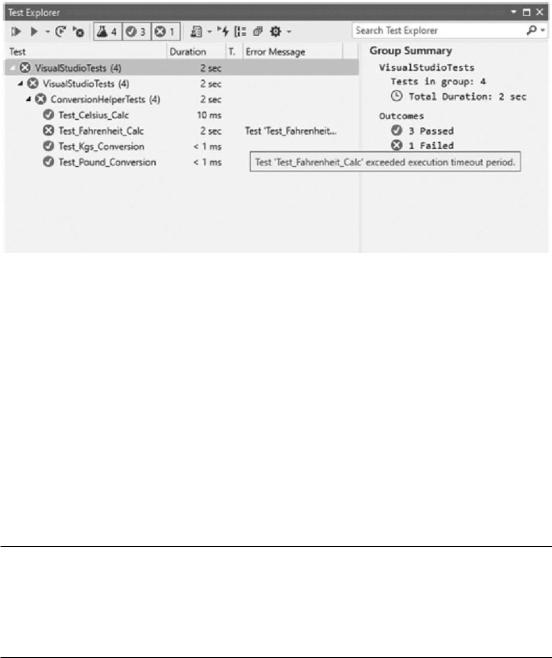
Chapter 4 Unit Testing
Figure 4-8. Test timeout exceeded
Identifying critical methods in your code and setting a specific timeout on that method will allow developers to catch issues early on when tests start exceeding the timeout set. You can then go back and immediately refactor the code that was recently changed to improve the execution time.
Using Live Unit Tests
First introduced in Visual Studio 2017, Live Unit Testing runs your unit tests automatically as you make changes to your code. You can then see the results of your unit tests in real time.
Live Unit Testing is only available in Visual Studio Enterprise edition for C# and Visual Basic projects targeting the .NET Framework or .NET Core. For a full comparison between the editions of Visual Studio, refer to the following link: https://visualstudio.microsoft.com/vs/compare/.
The benefits of Live Unit Testing are as follows:
•\ You will immediately see failing tests, allowing you to easily identify breaking code changes.
224
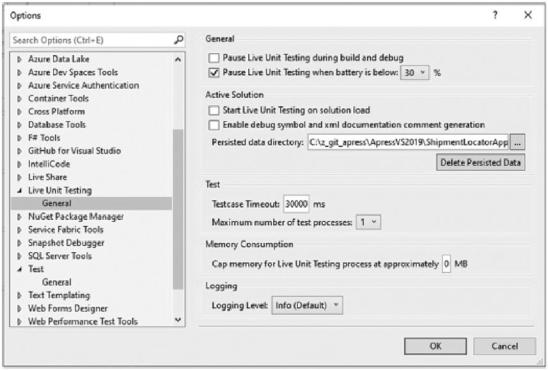
Chapter 4 Unit Testing
•\ It indicates Code Coverage, allowing you to see what code is not covered by any unit tests.
Live Unit Testing persists the data of the status of the tests it ran. It then uses the persisted data to dynamically run your tests as your code changes. Live Unit Testing supports the following test frameworks:
•\ |
xUnit.net – Minimum version xunit 1.9.2 |
•\ |
NUnit – Minimum version NUnit version 3.5.0 |
•\ |
MSTest – Minimum version MSTest.TestFramework 1.0.5-preview |
Before you can start using Live Unit Testing, you need to configure it by going to Tools Options and selecting Live Unit Testing in the left pane (Figure 4-9).
Figure 4-9. Configure Live Unit Testing
Once you have configured the Live Unit Testing options, you can enable it from TestLive Unit Testing Start. To see the Live Unit Testing window, click the Live Unit Testing button as seen in Figure 4-6.
225
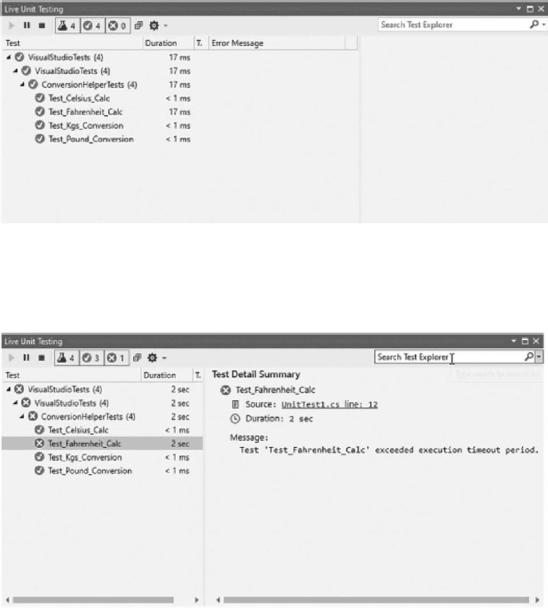
Chapter 4 Unit Testing
The Live Unit Testing window is displayed as seen in Figure 4-10.
Figure 4-10. Live Unit Testing window
Make some breaking changes to your code and save the file. You will see that the Live Unit Testing window is updated to display the failing tests as seen in Figure 4-11.
Figure 4-11. Live Unit Testing results updated
Live Unit Testing gives you a good insight into the stability of the code you write, as you write the code. Let’s go a little further. Add the class in Listing 4-7 to your project under test.
226
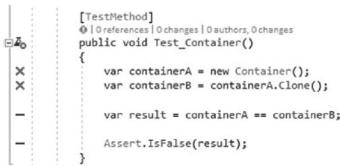
Chapter 4 Unit Testing
Listing 4-7. Container Class Implementing ICloneable
public class Container : ICloneable
{
public string ContainerNumber { get; set; } public string ShipNumber { get; set; } public double Weight { get; set; }
public object Clone() => throw new NotImplementedException();
}
Don’t add any implementation to the Clone method. Swing back to the test project and add a Unit Test for the Container class as in Listing 4-8.
Listing 4-8. Unit Test for the Container Class
[TestMethod]
public void Test_Container()
{
var containerA = new Container(); var containerB = containerA.Clone();
var result = (containerA == containerB); Assert.IsFalse(result);
}
Start Live Unit Testing, and you will notice that your test fails as seen in Figure 4-12.
Figure 4-12. Live Unit Test results failed
Have a look at the Container class, and you will notice that Live Unit Testing has also updated the code file with the faulting method (Figure 4-13).
227
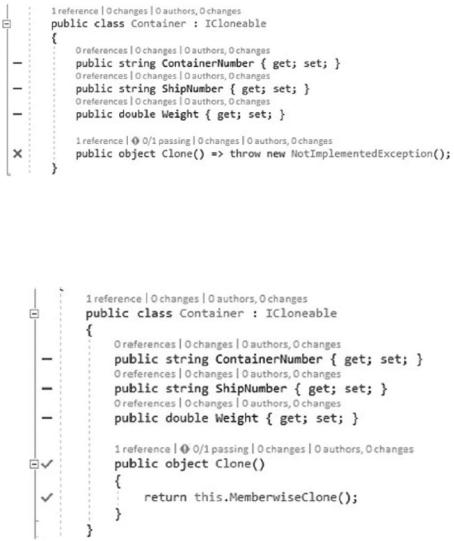
Chapter 4 Unit Testing
Figure 4-13. Container class Live Unit Test results
As soon as you add implementation to the Clone method, your Live Unit Test results are updated as seen in Figure 4-14.
Figure 4-14. Implementing the Clone method
With Live Unit Testing, areas of code indicated by a dash are not covered by any tests. A green tick indicates that the code is covered by a passing test. A red X indicates that the code is covered by a failing test.
228
